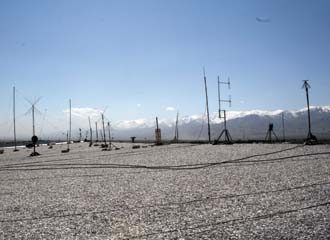Battlefield Virtualization Grows in Afghanistan
 |
The Bagram command and control center in Regional Command–East includes myriad rooftop antenna systems necessary to conduct operations. The command is consolidating servers and virtualizing battlefield operations. |
Officials in two areas of Afghanistan—Regional Command–South and Regional Command–East—are engaging in independent efforts to virtualize servers. The combined endeavors mark the first time the practice has been instituted in a theater of operations on such a large scale. And, according to NATO and U.S. sources in Afghanistan, it already is reaping rewards for the warfighters, including saving space, fuel, energy and money, while reducing system downtime and increasing data rates, memory and processing power.
NATO’s Consultation, Command and Control Agency (NC3A) is in charge of the virtualization effort in Regional Command–South, which comprises the area around Kandahar Province. The project reached full operational capability in March and has reduced the number of servers needed to power the Afghan Mission Network, arguably the largest battlefield network in the history of combat.
Virtualization is a process for using available space more efficiently on servers, explains Christopher Atiencia, senior systems administrator for the Kandahar Airfield Signal Support Group, which helps maintain systems in that province. In the past, one server likely would be dedicated to one purpose. To perform that one function, only 20 percent of the server’s resources might be used, including processing capacity and random access memory; the other 80 percent was unused and essentially wasted. In addition, without virtualization, when the server goes down, the application is not available until the hardware is repaired or replaced, a process that can take hours. With virtualization, however, one physical server hosts a number of virtual servers. This function utilizes the available processing power more effectively and requires fewer physical servers.
In Afghanistan, many of those applications are used to conduct the war, so server downtime can impact combat operations significantly. Applications can include an array of command, control, communications, computers, intelligence, surveillance and reconnaissance capabilities, such as full-motion video. Specific applications include JChat, a widely used NATO application. Chat applications are used so widely that they rapidly are overtaking voice radio as the preferred combat communications medium, according to officials in Afghanistan.
NATO’s Joint Operations Center Watch, or JOCWatch, an incident-reporting tool, is also widely used within theater. Another NC3A-provided application, iGeoSIT, is a geospatial intelligence tool used for situation awareness.
Virtual servers can be programmed to transfer to a different physical host automatically when they encounter problems. This process results in very little if any downtime and minimal effect on the warfighters. “A lot of that process is automatic. So if a server fails, it knows what virtual servers it has, and it just moves them over to a different box,” Atiencia explains.
In one case last year, the NC3A team took 10 hours to recover an exchange server that failed. The same type of catastrophic failure now could be fixed much more quickly. “With this system, if we had the same type of failure, it might take us a half hour to be up and running—and that’s the maximum. We could be up and running in five minutes,” Atiencia asserts.
In information technology “geek speak,” the NC3A’s virtualization effort has increased the number of nines, as in near-perfect percentage point effectiveness, available to the warfighter. “In the corporate world, a chief information officer or vice president of information will base his service-level agreement on the number of nines he can provide. So if he can provide his clients email services 99.9 percent of the time, he provides three nines. Then a company might come in and say it can provide three more nines—99.9999 percent. We’ve definitely increased the number of nines we provide because of what happens on the virtual server,” Atiencia asserts.
He could not say, however, how much the virtual system in Kandahar increases reliability because it is too new. An accurate assessment will require at least a year of data collection and analysis; however, the new system has seen practically zero downtime in the months it has been in use, he notes.
Virtual servers offer other benefits as well. Using fewer physical servers in a desert environment reduces power requirements for air conditioning, thereby using less electricity and decreasing the amount of fuel needed to power the generators that provide the electricity. In addition, the Regional Command–South effort has cut server space by as much as 60 percent and expanded the network backbone from two gigabytes to 10, a fivefold increase in data speed for warfighters.
U.S. Army officials in charge of Regional Command–East, the area around Bagram that borders Pakistan, expect similarly dramatic results from their virtualization effort. Traditionally, when Army units deploy, they take a large number of physical servers into the field that are dedicated to one purpose, a single application such as email or chat, for example, or a particular network such as the nonsecure Internet protocol router network or the secret Internet protocol router network.
Maj. Ben Ring, USA, chief information systems management officer for Regional Command–East and Combined Joint Task Force–101, points out that all those servers add up. “That takes up a lot of space. That consumes a lot of electricity, a lot of power. It puts off a lot of heat, so you have a lot of cooling requirements,” he says. “In a very ad hoc, austere environment such as Afghanistan, you have limited space, limited power, limited cooling. And when you have limitations, you run into problems—overheating, power failures, disruptions in services. And because we’ve become very dependent on all these digital systems, that has a major impact on operations.”
Creating virtual servers also means that a physical server can run a large number of servers, and those multiple hosts can be linked together. “So, we may have 10, 20 or 30 virtual servers. All of those hosts connect into a single network switch, which gives you connectivity to the outside world,” Maj. Ring says. “Separate from that is what we call shared storage. So, instead of nine terabytes of data, you now have 100 terabytes or 200 terabytes of available storage.”
Lt. Col. Joseph Hilfiker, USA, communications director for Regional Command–East and Combined Joint Task Force–101, explains that virtualization gives officials at his command the ability to build virtual data centers, so if one center is wiped out, another continuity of operations (COOP) site two miles down the road can be on stand-by to take over. “This is a great capability to build that COOP site and not be dependent on a single piece of hardware. What we’ve got, essentially, is a large computer with all this processing power. We’ve got this huge tank of memory available so that we’re not so worried about an individual hard drive going out. It is a tremendous capability for this theater,” the colonel says.
NC3A sources say that to their knowledge, this is the first time virtualization has been applied in a theater of operations. Col. Hilfiker asserts, however, that technically this is not true; the Battle Command Common Services (BCCS) stack, a small-scale virtualization capability, has been fielded at the brigade and battalion levels. “What we’re doing is much bigger and faster. BCCS is made for fighting out of a tent. In a really mature theater like this, the data requirements are just massive and still growing. It’s huge,” he states.
Although the virtualization projects in the two regional commands are being done independently, they both follow a set of common standards, Col. Hilfiker adds.
Army officials also say that virtualization has its limits in a battlefield environment. Forces in Afghanistan probably will never undergo the kind of large data center consolidation seen in a corporate environment, in part because the bandwidth is not available to move all servers to one location. Cloud computing on the battlefield is highly unlikely for the same reason. “This is short of cloud computing. We’re not there yet because of the bandwidth. Cloud computing requires an excessive amount of bandwidth, and we just don’t have that capability yet in this theater,” Maj. Ring says.
WEB RESOURCES
NATO Consultation, Command and Control Agency (NC3A): www.nc3a.nato.int/Pages/default.aspx
Regional Command–East: www.isaf.nato.int/subordinate-commands/rc-east/index.php




Comments